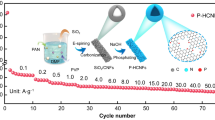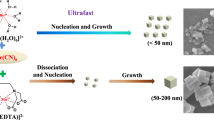Abstract
A key challenge in potassium ion batteries (PIBs) is the design of anode materials with advanced structures that can enable fast charge transport to enhance potassium storage performance. The use of iron carbodiimide (FeNCN) as the anode, containing a considerable number of covalent bonds and a stable structure at the molecular level, enables the achievement of excellent electrochemical performance of potassium storage systems. The FeNCN anode exhibits high electrical conductivity with a band gap close to 0 eV and decent structural stability owing to its covalently bonded structure. In addition, the amorphous reaction products provide multiple pathways to facilitate ion diffusion. Consequently, the FeNCN anode demonstrated a high reversible specific capacity (600 mA h g−1 at a current density of 50 mA g−1), remarkable rate capability, and long cycle life (a reversible specific capacity of 400 mA h g−1 at a current density of 500 mA g−1 over 300 cycles). The conversion mechanism between Fe2+ and K+ was revealed by theoretical simulation, in situ X-ray diffraction analysis, and X-ray photoelectron spectroscopy. Moreover, the as-assembled FeNCN//perylene-3,4,9,10-tetracarboxylic dianhydride full cell demonstrated a high energy density of 184.7 W h kg−1 (the highest among all iron-based PIBs) with a power density of 198.6 W kg−1, which is superior to the previously reported values for PIBs or potassium-ion hybrid capacitors.

摘要
钾离子电池(PIBs)面临的一个关键问题是设计具有先进结构的负极材料, 以实现快速电荷传输以提高钾的存储性能. 采用碳二亚胺铁(FeNCN)作为阳极, 由于其含有一定数量的共价键且在分子水平上具有稳定的结构, 使得储钾系统能够实现优异的电化学性能. FeNCN阳极具有高导电性, 带隙接近0 eV, 并且由于其共价键结构具有良好的结构稳定性. 此外, 无定形反应产物也为离子扩散提供了多种途径. 因此, FeNCN阳极表现出高可逆比容量(在50 mA g−1电流密度下具有600 mA h g−1比容量), 显著的倍率性能和长寿命循环(电流密度为500 mA g−1时拥有400 mA h g−1比容量且超过300次循环). 通过理论模拟、 X射线原位衍射分析和X射线光电子能谱分析揭示了Fe2+和K+之间的转化反应机理. 此外, 将FeNCN负极与苝-3,4,9,10-四羧酸二酐正极材料匹配, 组装成的全电池在198.6 W kg−1的功率密度下实现了184.7 W h kg−1的超高能量密度, 明显高于以往所有铁基负极的PIBs或钾离子混合电容器.
Similar content being viewed by others
References
Hosaka T, Kubota K, Hameed AS, et al. Research development on K-ion batteries. Chem Rev, 2020, 120: 6358–6466
Zhu J, Liu X, Wang W, et al. Universal low-temperature and template-free synthesis of sponge-like porous micron-sized elemental materials for high-performance lithium/potassium storage. Nano Energy, 2022, 95: 106981
Ge J, Fan L, Rao AM, et al. Surface-substituted Prussian blue analogue cathode for sustainable potassium-ion batteries. Nat Sustain, 2021, 5: 225–234
Yu D, Zhang W, Zhang Q, et al. Tuning anion chemistry enables high-voltage and stable potassium-based tellurium-graphite batteries. Nano Energy, 2022, 92: 106744
Wang W, Zhou J, Wang Z, et al. Short-range order in mesoporous carbon boosts potassium-ion battery performance. Adv Energy Mater, 2018, 8: 1701648
Min X, Xiao J, Fang M, et al. Potassium-ion batteries: Outlook on present and future technologies. Energy Environ Sci, 2021, 14: 2186–2243
Gu M, Rao AM, Zhou J, et al. In situ formed uniform and elastic SEI for high-performance batteries. Energy Environ Sci, 2023, 16: 1166–1175
Ge J, Wang B, Wang J, et al. Nature of FeSe2/N-C anode for high performance potassium ion hybrid capacitor. Adv Energy Mater, 2019, 10: 1903277
Huang YF, Yang YC, Tuan HY. Construction of strongly coupled few-layer FePSe3-CNT hybrids for high performance potassium-ion storage devices. Chem Eng J, 2023, 451: 139013
Liu Y, Shi Y, Gao C, et al. Low-temperature potassium batteries enabled by electric and thermal field regulation. Angew Chem Int Ed, 2023, 62: e202300016
Chen K, Fehse M, Laurita A, et al. Quantum-chemical study of the FeNCN conversion-reaction mechanism in lithium- and sodium-ion batteries. Angew Chem Int Ed, 2020, 59: 3718–3723
Guo P, Cao L, Wang R, et al. In situ construction of “anchor-like” structures in FeNCN for long cyclic life in sodium-ion batteries. Adv Funct Mater, 2020, 30: 2000208
Du Y, Zhang Z, Xu Y, et al. Metal sulfide-based potassium-ion battery anodes: Storage mechanisms and synthesis strategies. Acta Physico Chim Sin, 2022, 0: 2205017–0
Yan X, Ye Z, Ning G, et al. Molten salt pyrolysis synthesis of magnetic FeNCN nanorods and their visible-light-driven photocatalytic properties. Appl Surf Sci, 2020, 506: 145010
Li J, Wang R, Guo P, et al. Realizing fast charge diffusion in oriented iron carbodiimide structure for high-rate sodium-ion storage performance. ACS Nano, 2021, 15: 6410–6419
Sun J, Xu Y, Lv Y, et al. Recent advances in covalent organic framework electrode materials for alkali metal-ion batteries. CCS Chem, 2023, 5: 1259–1276
Sougrati MT, Darwiche A, Liu X, et al. Transition-metal carbodiimides as molecular negative electrode materials for lithium- and sodium-ion batteries with excellent cycling properties. Angew Chem Int Ed, 2016, 55: 5090–5095
Alahmadi M, Siaj M. Graphene-assisted magnetic iron carbide nanoparticle growth. ACS Appl Nano Mater, 2018, 1: 7000–7005
Liu XW, Cao Z, Zhao S, et al. Iron carbides in Fischer–Tropsch synthesis: Theoretical and experimental understanding in epsilon-iron carbide phase assignment. J Phys Chem C, 2017, 121: 21390–21396
Wei J, Xia D, Wei Y, et al. Probing the oxygen reduction reaction intermediates and dynamic active site structures of molecular and pyrolyzed Fe-N-C electrocatalysts by in situ Raman spectroscopy. ACS Catal, 2022, 12: 7811–7820
Qi H, Hou Y, Wang W, et al. Controlled phase and crystallinity of FeNCN/NC dominating sodium storage performance. Dalton Trans, 2022, 51: 8223–8233
Müller RJ, Lan J, Lienau K, et al. Monitoring surface transformations of metal carbodiimide water oxidation catalysts by operando XAS and Raman spectroscopy. Dalton Trans, 2018, 47: 10759–10766
Zhu A, Qiao L, Tan P, et al. Iron-nitrogen-carbon species for oxygen electro-reduction and Zn-air battery: Surface engineering and experimental probe into active sites. Appl Catal B-Environ, 2019, 254: 601–611
He Q, Yu B, Li Z, et al. Density functional theory for battery materials. Energy Environ Mater, 2019, 2: 264–279
Wu S, Wang W, Shan J, et al. Conductive 1T-VS2-MXene heterostructured bidirectional electrocatalyst enabling compact Li-S batteries with high volumetric and areal capacity. Energy Storage Mater, 2022, 49: 153–163
Li W, Shen P, Yang L, et al. Novel Cu(Zn)-Ge-P compounds as advanced anode materials for Li-ion batteries. Energy Environ Sci, 2021, 14: 2394–2407
Jin T, Li H, Li Y, et al. Intercalation pseudocapacitance in flexible and self-standing V2O3 porous nanofibers for high-rate and ultra-stable K ion storage. Nano Energy, 2018, 50: 462–467
Gan Z, Yin J, Xu X, et al. Nanostructure and advanced energy storage: Elaborate material designs lead to high-rate pseudocapacitive ion storage. ACS Nano, 2022, 16: 5131–5152
Yuan D, Dou Y, Tian Y, et al. Robust pseudocapacitive sodium cation intercalation induced by cobalt vacancies at atomically thin Co1−xSe2/graphene heterostructure for sodium-ion batteries. Angew Chem Int Ed, 2021, 60: 18830–18837
Du Y, Weng W, Zhang Z, et al. Candied-haws-like architecture consisting of FeS2@C core-shell particles for efficient potassium storage. ACS Mater Lett, 2021, 3: 356–363
Hong W, Wang A, Li L, et al. Bi dots confined by functional carbon as high-performance anode for lithium ion batteries. Adv Funct Mater, 2020, 31: 2000756
Lai C, Zhang Z, Xu Y, et al. A general strategy for embedding ultrasmall CoMx nanocrystals (M = S, O, Se, and Te) in hierarchical porous carbon nanofibers for high-performance potassium storage. J Mater Chem A, 2021, 9: 1487–1494
Liu M, Xing Y, Wang J, et al. Besides the capacitive and diffusion control: Inner-surface controlled bismuth based electrode facilitating potassium-ion energy storage. Adv Funct Mater, 2021, 31: 2101868
Hu J, Xie Y, Zheng J, et al. Unveiling nanoplates-assembled Bi2MoO6 microsphere as a novel anode material for high performance potassium-ion batteries. Nano Res, 2020, 13: 2650–2657
Gaberšček M. Understanding Li-based battery materials via electrochemical impedance spectroscopy. Nat Commun, 2021, 12: 6513
Liu M, Zhang J, Sun Z, et al. Dual mechanism for sodium based energy storage. Small, 2023, 19: 2206922
Wang A, Hong W, Li L, et al. Hierarchical bismuth composite for fast lithium storage: Carbon dots tuned interfacial interaction. Energy Storage Mater, 2022, 44: 145–155
Liao J, Hu Q, Du Y, et al. Robust carbon nanotube-interwoven KFeSO4F microspheres as reliable potassium cathodes. Sci Bull, 2022, 67: 2208–2215
Liu S, Mao J, Zhang Q, et al. An intrinsically non-flammable electrolyte for high-performance potassium batteries. Angew Chem Int Ed, 2020, 59: 3638–3644
Fan L, Ma R, Yang Y, et al. Covalent sulfur for advanced room temperature sodium-sulfur batteries. Nano Energy, 2016, 28: 304–310
Niu X, Zhang Y, Tan L, et al. Amorphous FeVO4 as a promising anode material for potassium-ion batteries. Energy Storage Mater, 2019, 22: 160–167
Li S, Qin J, Gao T, et al. Fabrication of Fe3C nanoparticles embedded in N-doped carbon nanotubes/porous carbon 3D materials derived from distilled grains for high performance of potassium ion battery. J Alloys Compd, 2022, 912: 165130
Lu S, Wu H, Xu S, et al. Iron selenide microcapsules as universal conversion-typed anodes for alkali metal-ion batteries. Small, 2021, 17: 2005745
Park JS, Yang SY, Lee JK, et al. A novel strategy for encapsulating metal sulfide nanoparticles inside hollow carbon nanosphere-aggregated microspheres for efficient potassium ion storage. J Mater Chem A, 2022, 10: 17790–17800
Cui Y, Feng W, Wang D, et al. Water-soluble salt template-assisted anchor of hollow FeS2 nanoparticle inside 3D carbon skeleton to achieve fast potassium-ion storage. Adv Energy Mater, 2021, 11: 2101343
Wang WA, Huang H, Wang B, et al. A new dual-ion battery based on amorphous carbon. Sci Bull, 2019, 64: 1634–1642
Wei Z, Wang D, Yang X, et al. From crystalline to amorphous: An effective avenue to engineer high-performance electrode materials for sodium-ion batteries. Adv Mater Interfaces, 2018, 5: 1800639
Zhang Z, Li M, Gao Y, et al. Fast potassium storage in hierarchical Ca0.5Ti2(PO4)3@C microspheres enabling high-performance potassium-ion capacitors. Adv Funct Mater, 2018, 28: 1802684
Zhu Z, Cheng F, Hu Z, et al. Highly stable and ultrafast electrode reaction of graphite for sodium ion batteries. J Power Sources, 2015, 293: 626–634
Ming F, Liang H, Zhang W, et al. Porous MXenes enable high performance potassium ion capacitors. Nano Energy, 2019, 62: 853–860
Lei K, Wang C, Liu L, et al. A porous network of bismuth used as the anode material for high-energy-density potassium-ion batteries. Angew Chem Int Ed, 2018, 57: 4687–4691
Le Z, Liu F, Nie P, et al. Pseudocapacitive sodium storage in mesoporous single-crystal-like TiO2-graphene nanocomposite enables high-performance sodium-ion capacitors. ACS Nano, 2017, 11: 2952–2960
Acknowledgements
This work was financially supported by the National Natural Science Foundation of China (52074113, 22005091 and 22005092), Hunan University Outstanding Youth Science Foundation (531118040319), the Science and Technology Innovation Program of Hunan Province (2021RC3055), Changsha Municipal Natural Science Foundation (43184), the CITIC Metals Ningbo Energy Co., Ltd. (H202191380246), Chongqing Talents: Exceptional Young Talents Project (CQYC202105015), and Shenzhen Virtual University Park Basic Research Project of Free exploration (2021Szvup036).
Author information
Authors and Affiliations
Contributions
Author contributions Zhu J conceived the idea and directed the study. Jia X performed the main experiments. Jia X and Li S discussed the experiments and data. Jia X and Chen S, Wang L, Sun H, Fu L, and Zhu J drafted the manuscript. Deng H and Yuan Y participated in the sample preparation and characterization. All authors participated in the interpretation of the data and preparation of the final manuscript.
Corresponding authors
Ethics declarations
Conflict of interest The authors declare that they have no conflict of interest.
Additional information
Jian Zhu received a PhD degree in 2017 from Hunan University. Now, he is a professor and doctoral supervisor at Hunan University. He mainly investigates the application of functional nanomaterials in electrochemical energy storage.
Xinxin jia is pursuing her doctoral degree at the College of Materials Science and Engineering, Hunan University. Her research interest is anode materials and their applications in PIBs.
Supplementary information Supporting data are available in the online version of the paper.
Electronic supplementary material
Rights and permissions
About this article
Cite this article
Jia, X., Li, S., Chen, S. et al. Covalently bonded metal-organic groups anodes for high-performance potassium-ion batteries. Sci. China Mater. 66, 3827–3836 (2023). https://doi.org/10.1007/s40843-023-2532-x
Received:
Accepted:
Published:
Issue Date:
DOI: https://doi.org/10.1007/s40843-023-2532-x




